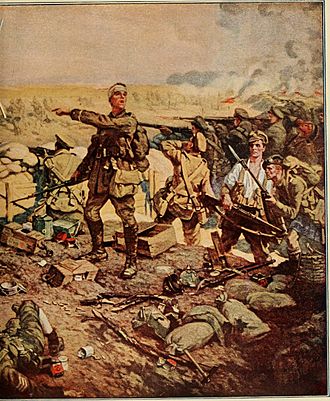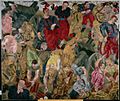Second Battle of Ypres facts for kids
Quick facts for kids Second Battle of Ypres |
|||||||
|---|---|---|---|---|---|---|---|
| Part of the Western Front of the First World War | |||||||
|
Canadian troops in the battle |
|||||||
|
|||||||
| Belligerents | |||||||
| Commanders and leaders | |||||||
| Strength | |||||||
| 8 infantry divisions—2 French divisions and 6 British, Canadian, and Newfoundland divisions | 7 infantry divisions | ||||||
| Casualties and losses | |||||||
| 70,000 dead, wounded, or missing | 35,000 dead, wounded, or missing | ||||||
The Second Battle of Ypres was a major fight during World War I. It took place in the spring of 1915 near the town of Ypres in western Belgium. This battle was very important because it was the first time Germany used poison gas on a large scale on the Western Front. It also marked a new and dangerous turning point in the war, as gas attacks would cause many more casualties for both sides.
Contents
Before the Battle: Hill 60
Before the Second Battle of Ypres, there was another important fight over a place called Hill 60. This hill was on the southeast side of the Ypres Salient, which was a part of the battle line that stuck out into enemy territory.
- The Allies (France, Britain, and their partners) captured Hill 60 just five days before the main battle began.
- Hill 60 was a great spot to see what was happening in the area, making it a valuable observation post.
- It played a role in the bigger battle that followed.
Rules of War and Gas
Before World War I, international agreements like the Geneva Conventions of 1899 and 1907 tried to set rules for war. These rules did not allow "projectiles" (things shot from weapons) that carried poison gas.
- However, before the Second Battle of Ypres, the Germans placed about 5,700 cylinders filled with chlorine gas in front of their trenches.
- For weeks, the Allied commanders received information that Germany planned to use poison gas.
- But they did not believe Germany would actually do it.
The First Gas Attacks
The first soldiers to be hit by the chlorine gas attack were mostly French and Algerian troops. They were not ready for this new kind of weapon.
- When the chlorine gas was released, the French soldiers began to retreat in large numbers.
- This left the Canadians fighting without their French allies, creating a big gap in the battle lines.
- However, the Germans were not prepared for how well the gas worked. They did not have enough reserve soldiers to quickly attack the open area.
- The 1st Canadian Division and British troops quickly moved to fill the gap and stop the German advance.
How Soldiers Dealt with Gas
During the battle, some German soldiers tried to open gas valves that had frozen. This meant they were also exposed to the dangerous gas.
- By the end of the battle, both the Allies and Germans had many casualties from the gas attacks.
- The Canadians alone had over 6,000 soldiers killed, wounded, or missing.
- At that time, Gas masks did not exist.
- But a Canadian ceramic maker quickly figured out the color of the gas. He told the soldiers to urinate on a towel and hold it over their faces. This simple trick helped filter the gas and saved many Canadian lives.
This battle was actually the second time Germany had used gas in World War I. The first time was in February 1915 at the Battle of Bolimov in Russia. However, the freezing temperatures there caused the gas to fall harmlessly to the ground.
Images for kids
-
Fritz Haber, a German chemist who suggested using heavier-than-air chlorine gas as a weapon to break the trench deadlock.
-
A grave in Kells, County Meath, Ireland, for a soldier from the Leinster Regiment who died at Bellewaarde.
See also
 In Spanish: Segunda batalla de Ypres para niños
In Spanish: Segunda batalla de Ypres para niños








